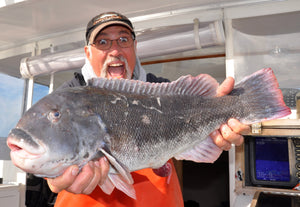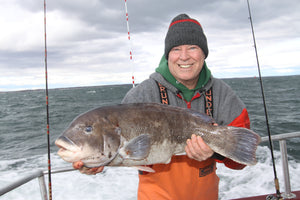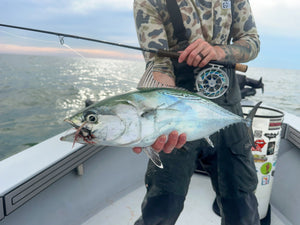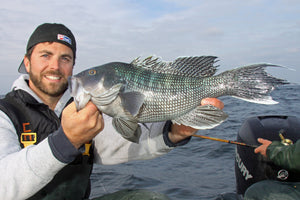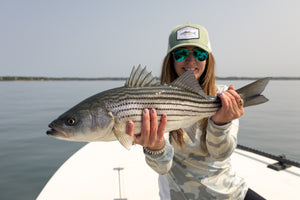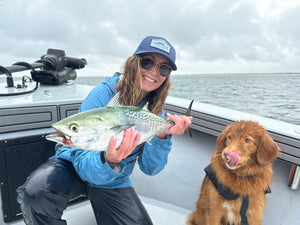Coastal Giants: Part 2

So, just how do you go about working up your first coastal giant bluefin?
It’s always good to have a game plan before heading out. Start by checking recent fishing reports for action with big tuna, and see if you can get a feel for where successful anglers have been encountering thick schools of baitfish like blues, mackerel, butterfish, bunker or sand eels.
Once underway with a general spot or direction in mind, keep an eye out for any signs that might tip you off to pods of tuna on the feed. Surface activity like nervous pods of bunker, sea birds diving on baitfish – or the obvious tuna crashing the surface - are all worthy of investigation. Should you come across a fleet of boats in a known tuna spot, slowly cruise or drift a respectable distance outside the perimeter of the pack to see if anyone has hooked-up. Now, before you ever put a bait or lure in the water, is also a good time to discuss with your crew release tactics and how you intend to get a big fish into the boat should the fishing Gods smile on your adventure.

Giant coastal tuna respond to a variety of fishing methods with trolling, drifting live baits and tossing surface poppers all having fans. White Water Outfitters proprietor, Bryce Poyer, is an expert in all three modalities. He has numerous billfish and tuna tournament wins to his credit, and he runs big game charter trips out of W.W.O. aboard his 2022 Conch 27' center console. “This sport takes a lot of patience,” points out Poyer. “It’s a big ocean out there and even if the fish are feeding nearshore, you might need some time to lock them in. I start my searches by looking for bait, temperature breaks, slicks and surface activity. Once I zero in on the fish, I’ll decide which method of catching them fits my crew, my tackle, and the size of these beasts.”
Troll With Ballyhoo
Trolling, notes Poyer is a good way to combine your search for tuna with lines in the water. “You can cover a large area with broad strokes while making a large grid pattern with straight-line trolls,” he points out. Poyer recommends trolling specifically for bluefins in the 50 -to 60-inch class, which is the majority of what you are likely to encounter during the late summer and fall season off Long Island’s South Shore. “A 60-inch bluefin probably weighs about 125 pounds,” he explains. “That makes it an ideal size for trolling fun, especially for those new to the sport.”
In terms of bait or lures, ballyhoo is a good choice. Rig a select or horse size ballyhoo with a Joe Shute style skirt on top of it, and troll at 4 to 6 knots. You’ll want to use 70-class trolling outfits at a minimum, but 80- and 130-class outfits are preferred when targeting these larger fish. Set up with a 150- to 180-pound-test leader based on the size of the fish expected and position your bait 100 to 200 yards astern.
Bryce suggests putting out just two or three rods. A typical spread, he explains, might offer two ballyhoo set way back on the long riggers and a single planer board set at 20 to 50 feet below the surface with a ballyhoo positioned 150 to 250 feet further back. “There’s no need for spreaders or side-tracking bars unless you want to cull out a smaller fish,” stresses Poyer. “When targeting big fish, less is usually more.”
Live Bait On The Drift
Tempting tuna with live bait is another way to get the job done. As selective as tuna can be at times, the big ones eat a variety of large live baits including bluefish, mackerel, butterfish, porgy and bunker. Drift any of these under biodegradable latex balloons.
“This method works great when bait is stacked or tightly schooled,” continues Poyer. “Set your baits of choice back 75 feet from a biodegradable latex fishing balloon positioned 150 feet off the stern. If the current is pushing, consider adding a little weight to hold the bait down in the water column. Work from mid-depth to two-thirds down the water column and you’ll be in the appropriate strike zone.”
Standard rigging for live-lining coastal tuna calls for a 130- to 200-lb. leader and a size 8/0 to 10/0 tuna hook, depending on the size of the bait. Once again, 70-class outfits are sometimes suitable, but 130s or 80s are highly recommended because they have the extra strength needed to manage bigger fish in a reasonable amount of time.

“Generally speaking, there’s no chunking or chumming needed for live-bait tuna success,” points out Poyer. “Just get those baits out behind the boat a respectable distance and you should do fine. Concentrate your efforts around bunker pods, bluefish schools, and draggers that are working shallow this time of year. You can also look for birds picking bait, slicks, etc.”
Popping Giants
As for popping coastal giants on spinning gear, be careful what you wish for. “It can be a real blast,” says Poyer, “but not if you are overmatched. Be realistic about your own capabilities, the experience of your crew, and the limits of your gear should you go this route.”
Some of the tuna you’ll encounter on these short run adventures are clearly big enough to destroy lures, snap lines, and overpower spinning setups. Use your best judgement in these situations – and consider that it may be better for both you and your quarry if you pass on something that looks like it can dump a 14000-size spinning reel in a hurry.
That said, tuna in the 100- to 200-pound class should be fair game and a ton of fun. If you happen upon them feeding on the surface, pull up close enough to lead the pack with a mid-range cast, get your line out, and start popping with long, sharp pulls. One thing is for sure with this method: You’ll never have to wonder if a fish has inhaled your offering!
Of course, all of the above is intended to serve as just a quick introduction to targeting coastal bluefins. Feel free to stop by the shop for more information on lures, rigging, tackle, plus the end game. We’ll get you up to speed – and offer some thoughts on the current bluefin bite to help you zero in on the action.
- Bryce Poyer

